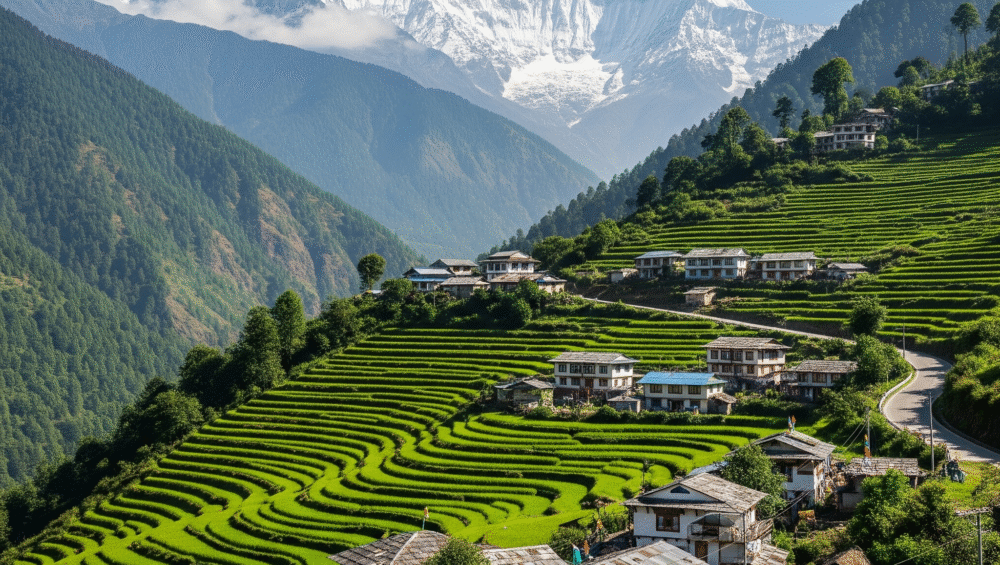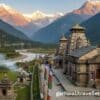Places to visit in Pipalkoti Chamoli
Nestled amidst the majestic Garhwal Himalayas in Uttarakhand, Pipalkoti serves as a serene and strategic base for exploring the region’s breathtaking natural beauty and profound spiritual heritage. More than just a transit point, this charming town offers a tranquil escape and direct access to some of the most revered pilgrimage sites and stunning landscapes in the Indian Himalayas. From ancient temples echoing tales of devotion to verdant valleys and snow-capped peaks that inspire awe, Pipalkoti is truly a gateway to unforgettable experiences.
Here’s a curated guide to the captivating places you can explore from Pipalkoti, each promising a unique journey of discovery:
Sacred Sanctuaries and Confluences
- Gopinath Temple: A short distance from Pipalkoti lies the revered Gopinath Temple, a significant abode dedicated to Lord Shiva. This ancient shrine is not only an architectural marvel with its unique pyramid-shaped roof but also a place steeped in mythology, believed to be where Lord Shiva’s trident pierced the earth. Devotees flock here seeking blessings, while its tranquil surroundings offer a perfect setting for introspection and spiritual solace. The temple’s historical charm and serene ambiance make it a must-visit for those seeking a deeper connection with the divine.
- Chamoli: Situated at an elevation of 1300 meters on the sacred banks of the Alaknanda River, Chamoli is a picturesque town that serves as the district headquarters. This vibrant hub beautifully blends natural splendor with cultural richness. Visitors can immerse themselves in the local Garhwali culture, explore bustling markets, and enjoy panoramic views of the surrounding mountains. Chamoli’s strategic location makes it an ideal stopover, offering modern amenities amidst a pristine Himalayan backdrop, perfect for refreshing before venturing deeper into the spiritual journey.
- Nandprayag: A small yet profoundly spiritual town, Nandprayag is distinguished by the holy confluence of the Alaknanda and Nandakini Rivers. This sacred meeting point is one of the five Panch Prayags, holding immense significance for pilgrims. The pristine waters and the spiritual energy of the confluence create a truly enchanting atmosphere, inviting visitors to witness a divine spectacle. It’s a place where the powerful flow of nature intertwines with deep-rooted faith, offering a serene environment for reflection and spiritual rejuvenation.
- Anusuya Devi Temple & Atri Muni Ashram: Tucked away amidst dense forests, this revered pilgrimage site is dedicated to Goddess Sati, the virtuous wife of the sage Atri Muni. The temple is famed for its spiritual power, particularly for women seeking blessings for progeny. The journey to the temple itself is an invigorating trek, passing through lush greenery and offering glimpses of untouched natural beauty. The adjacent Atri Muni Ashram provides a tranquil space for meditation and spiritual learning, making it a profound destination for devotees and seekers of peace.
- Kalpeshwar: The only Panch Kedar temple that remains open throughout the year, Kalpeshwar is the fifth and final temple in the revered Panch Kedar pilgrimage circuit dedicated to Lord Shiva. This unique temple houses the matted hair (Jata) of Shiva. The trek to Kalpeshwar is relatively less strenuous than other Kedar temples, making it accessible to a wider range of pilgrims. Its year-round accessibility and serene location in the Urgam Valley make it a unique spiritual destination, offering continuous blessings and a deep connection to ancient Hindu mythology.
Natural Vistas and Adventure Hubs
- Govindghat: A pristine hamlet located at the confluence of the Alaknanda and Lakshman Ganga rivers, Govindghat serves as a crucial starting point for treks to Hemkund Sahib and the Valley of Flowers. Adorned by pilgrims and adventurers alike, this hamlet offers a vibrant atmosphere where spiritual journeys intertwine with thrilling expeditions. The majestic river confluence provides a picturesque setting for reflection, while the surrounding trails beckon those eager to explore the unparalleled beauty of the Himalayan landscape. Its strategic location makes it a lively base for both spiritual seekers and nature enthusiasts.
- Vishnuprayag: A captivating city nestled at 1,372 meters, Vishnuprayag is celebrated for the sacred confluence of the Alaknanda and Dhauliganga rivers. This serene spot, one of the Panch Prayags, is a visual delight where the emerald waters of the Alaknanda meet the forceful flow of the Dhauliganga. The area is not only spiritually significant but also offers breathtaking views of the surrounding mountains and valleys. It’s an ideal location for nature lovers and photographers to capture the raw beauty of the Himalayas and the tranquil harmony of its rivers.
- Chenap Valley: Often referred to as one of Uttarakhand’s hidden gems, Chenap Valley is a high-altitude paradise nestled at approximately 13,000 feet. This pristine valley is renowned for its vibrant meadows, particularly during the blooming season, when it transforms into a carpet of diverse Himalayan flowers. It offers an unspoiled natural experience away from the usual tourist trails, making it perfect for trekkers and nature enthusiasts seeking solitude and breathtaking vistas. The challenging yet rewarding journey to Chenap Valley unveils unparalleled views of untouched wilderness and towering peaks.
- Chopta & Tungnath: Often referred to as the ‘Mini Switzerland of Uttarakhand,’ Chopta is a picturesque hamlet renowned for its vast, emerald green meadows and panoramic views of the Himalayan range. It serves as the base for the trek to Tungnath, the highest Shiva temple in the world, peacefully situated on the Chandranath Parvat. The trek to Tungnath offers stunning vistas, leading pilgrims and trekkers through rhododendron forests and vast alpine pastures. From Tungnath, a further ascent leads to Chandrashila peak, rewarding visitors with a 360-degree view of the prominent Himalayan peaks. This combined destination offers a perfect blend of spiritual solace and thrilling adventure.
- Mandal: A tiny, remote hamlet in the Chamoli district, Mandal is a hidden treasure for those seeking an authentic rural Himalayan experience. Surrounded by dense forests and offering serene tranquility, this village is considered a must-visit for its untouched natural beauty and cultural simplicity. It provides a glimpse into the traditional life of the Garhwali people, offering opportunities for peaceful walks, birdwatching, and enjoying the serene mountain air. Mandal is an ideal retreat for those looking to escape the hustle and bustle and immerse themselves in nature’s calm embrace.
- Auli: A renowned hill station, Auli is celebrated as one of India’s premier ski resorts and a popular winter destination. Perched at an elevation of over 2,500 meters, it offers mesmerizing panoramic views of Nanda Devi, Mana Parvat, and other Himalayan peaks. Beyond skiing, Auli is a year-round destination offering lush meadows in summer, ideal for trekking and nature walks. The Auli Ropeway, one of Asia’s longest, provides a thrilling ride with spectacular aerial views. Its pristine natural beauty and adventure sports opportunities make it a magnet for tourists seeking both thrills and tranquility.
Cultural Insights and Himalayan Villages
- Sagar Village: Located in the Chamoli district, Sagar Village is not just a settlement but a pathway to several holy temples of high significance within Uttarakhand and Hindu culture. This quaint village offers a glimpse into the traditional Garhwali way of life, with its terraced fields and simple charm. Visitors can experience the local hospitality, learn about ancient customs, and embark on treks to nearby spiritual sites. Sagar Village provides a unique opportunity to connect with the spiritual heartland of the region while enjoying the serene rural landscape.
- Gopeshwar: The headquarters of the Chamoli district, Gopeshwar is a vibrant town situated at 1300 meters above sea level, celebrated for its ancient temples and captivating natural beauty. The town is home to the ancient Rudranath Temple, dedicated to Lord Shiva, which draws numerous devotees. Gopeshwar beautifully combines administrative importance with spiritual sanctity, offering a blend of modern amenities and traditional charm. Its pleasant climate and scenic surroundings make it an attractive destination for both pilgrims and tourists seeking to explore the cultural and natural essence of the region.
- Urgam Village: Tucked away in the picturesque Urgam Valley near Joshimath, Urgam Village is a scenic hamlet perched at an elevation of about 2100 meters. Surrounded by majestic snow-clad peaks, this serene village is a haven of tranquility and natural beauty. It’s renowned for its apple orchards and traditional wooden houses, offering a genuine insight into Himalayan village life. Urgam serves as a base for treks to various local temples and offers an immersive experience into the untouched beauty and cultural richness of the region, far from the madding crowds.
- Malari: A small, remote village near the Indo-Tibetan border, Malari is nestled in the Dhauli Ganga valley at an elevation of 3048 meters, encircled by steep, snow-covered mountains. This strategically important village offers a unique cultural experience, influenced by its proximity to the border. Malari is a base for various high-altitude treks and provides stunning views of the pristine Himalayan wilderness. Its untouched natural beauty and the opportunity to observe a distinct border culture make it an intriguing destination for adventurous travelers and those interested in remote Himalayan life.
- Mana Village: Designated as a “Tourism Village” by the Uttarakhand government, Mana is famously known as the “last Indian village” before the border with Tibet/China in the Himalayas. Located in the Chamoli district, this charming village is adorned with colorful houses and offers a unique cultural experience. It is a vital stop for pilgrims heading to Badrinath and a significant historical site with connections to the Mahabharata. Visitors can explore local handicrafts, interact with the amiable Bhotia community, and marvel at the breathtaking views of the surrounding mountains, making it a culturally rich and visually stunning destination.
Pivotal Pilgrimage and Trekking Bases
- Badrinath: One of the four dominant Char Dham pilgrimage sites in India, Badrinath is a profoundly sacred town perched at an average elevation of 3,300 meters on the banks of the Alaknanda River. Dedicated to Lord Vishnu, the temple is an architectural marvel and a beacon of Hindu faith. Surrounded by towering peaks like Nar and Narayana, and the Neelkanth peak, the spiritual ambiance is palpable. Badrinath attracts millions of devotees annually, seeking salvation and divine blessings, making it a cornerstone of spiritual tourism in the Himalayas.
- Joshimath: Also known as Jyotirmath, Joshimath is a sacred town nestled in the Chamoli district, serving as a significant pilgrimage center and the winter seat of Lord Badrinath. Situated at the confluence of the Alaknanda and Dhauliganga rivers, it is a crucial base for trekkers and pilgrims heading to Badrinath, Auli, and the Valley of Flowers. Joshimath is home to ancient temples, including the Narasimha Temple, and is a gateway to numerous Himalayan expeditions. Its strategic location and spiritual significance make it a bustling hub of activity and devotion.
- Pandukeshwar: A sacred place located en-route to Badrinath at an elevation of 1829 meters, Pandukeshwar holds immense mythological significance. It is believed to be the place where King Pandu, father of the Pandavas, meditated and installed the idol of Lord Vishnu. The village is home to the ancient Yogadhyan Badri Temple, one of the Sapt Badri temples, and is surrounded by picturesque Himalayan landscapes. Its serene environment and rich mythological ties make it a peaceful stop for pilgrims and a place to delve into ancient Indian legends.
Pipalkoti, with its strategic location and access to such diverse attractions, truly offers a holistic Himalayan experience. Whether you seek spiritual enlightenment, thrilling adventures, or simply a tranquil retreat amidst nature’s grandeur, this charming town serves as your perfect starting point for an unforgettable journey into the heart of Uttarakhand.





